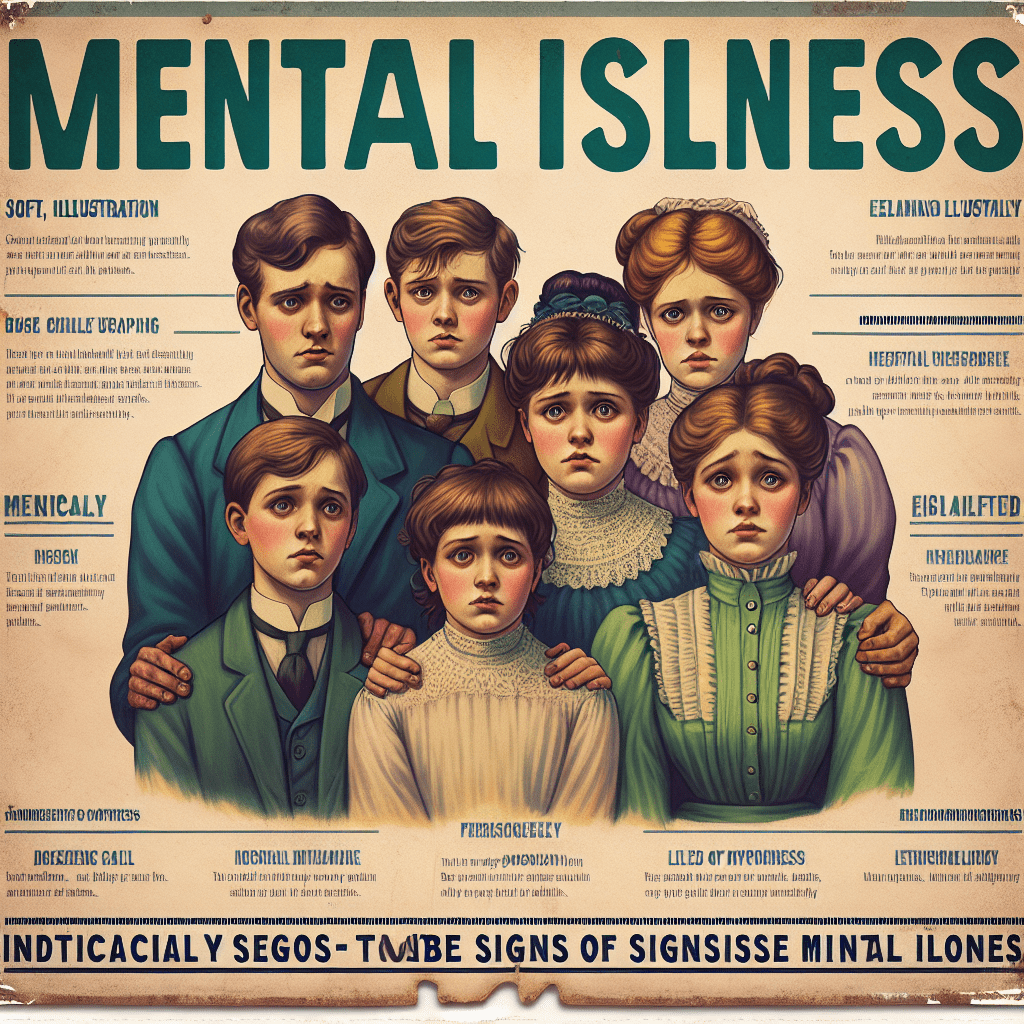Get your free Book Here

Spotting the Signs: How to Recognize Mental Illness in Your Family
Understanding mental illness in family members can be one of the most challenging yet vital aspects of maintaining healthy relationships. Just like any other health issue, mental health problems can manifest in various ways, often hiding in plain sight. As a life coach, I want to equip you with the knowledge to identify potential signs of mental illness in your loved ones, assisting you in navigating these tricky waters with compassion and awareness.
This blog post breaks down the nuanced realm of mental health into eight highlighted chapters, offering insights and tools essential for spotting the signs of mental illness in your family. So, let’s dive in!
1. Understanding Mental Illness
Mental health refers to our emotional, psychological, and social well-being; it affects how we think, feel, act, and relate to others. Recognizing that mental illness is a genuine health concern and not a flaw of character is essential. Mental illnesses can range from anxiety disorders, depression, and schizophrenia to more severe conditions like bipolar disorder.
Knowing the common types of mental illness is the first step to understanding what your family members might be experiencing. The stigma surrounding mental health often discourages open discussions, making it paramount to foster a supportive atmosphere at home.
2. Identifying Behavioral Changes
One vital sign of mental illness in your family is a noticeable change in behavior. People are often quick to spot physical symptoms but overlook subtle shifts in personality and conduct. Think about how your loved ones usually behave—are they more withdrawn than usual, displaying irritability, or displaying devastation or emotional numbness?
Behavioral changes may include:
- Loss of Interest: Sudden disinterest in activities and hobbies they once enjoyed.
- Isolation: Withdrawing from family or social situations.
- Mood Swings: Experiencing unexplained fluctuations in mood.
When changes become evident, take note and consider a gentle, open approach to discuss your concerns with them.
3. Monitoring Emotional Responses
Emotions are often the key indicators of mental health issues. Watch for persistent feelings of sadness, anger, anxiety, or emptiness. For instance, if a family member frequently expresses feelings of hopelessness or persistent sadness lasting more than a few weeks, it may be time to take action.
Other emotional signs might include:
- Excessive Worry: Constant worry about everyday scenarios.
- Irritability: Increased frustration over minor inconveniences.
- Extreme Reactions: Disproportionate emotional responses, like crying or rage.
Recognizing emotional distress allows you to support your loved ones while encouraging them to seek help if necessary.
4. Physical Signs to Look For
Mental illness often manifests physically. Pay attention to any changes in sleeping and eating habits, as these may serve as significant indicators of a mental health problem.
Common physical signs include:
- Sleep Disturbances: Insomnia or hypersomnia can indicate underlying stress or anxiety.
- Changes in Appetite: Noticeable weight gain or loss may reflect the mental state of your loved one.
- Neglecting Personal Hygiene: Lack of interest in personal grooming or cleanliness.
These symptoms are not only distressing for the individual but also for those around them. Being observant can prompt you to offer assistance or engage in a conversation about their well-being.
5. Recognizing Cognitive Struggles
Cognitive disturbances often accompany mental health issues, hindering one’s ability to think clearly or concentrate. You may notice your loved one struggling with decision-making, memory lapses, or decreased productivity at work or school.
Examine the following:
- Decline in Performance: A sudden drop in performance at work or school can indicate a deeper issue.
- Difficulty Focusing: Trouble starting or completing tasks may suggest cognitive dissonance.
- Confusion: An unusual level of forgetfulness or confusion might require further exploration.
If such signs persist, these could be indicative of more significant mental health challenges that necessitate professional intervention.
6. Understanding Substance Abuse Patterns
Substance abuse and mental illness often accompany one another, creating a complex web that can further complicate situations in families. Many individuals turn to alcohol or drugs to self-medicate, which can aggravate existing mental health issues.
Be vigilant for:
- Increased Use: A marked increase in the consumption of alcohol or recreational drugs.
- Neglecting Responsibilities: Prioritizing substance use over personal, professional, or familial duties.
- Isolation: Spending excessive time alone with substances rather than engaging with family or friends.
Recognizing these patterns can lead to timely interventions or treatment options that may make a significant difference.
7. Encouraging Open Dialogue
Once you have observed concerning signs, allowing space for an open dialogue can be crucial. It can be challenging to start these conversations, but expressing genuine concern and love lays a strong foundation for a supportive exchange.
Consider these tips:
- Be Compassionate: Approach them from a place of love, ensuring they feel safe to express themselves without judgment.
- Listen Actively: Sometimes, the best way to help is simply to listen. Give them a platform to share their experiences.
- Normalize Help-Seeking: Encourage seeking professional help as a positive step rather than a sign of weakness.
Creating a nurturing environment where mental health is openly discussed fosters a stronger foundation for recognition and recovery.
8. Seeking Professional Help
If you notice persistent signs of mental illness despite your efforts to communicate, it may be time to encourage professional help. A qualified mental health professional can determine an accurate diagnosis and offer effective treatment plans.
Guidelines for seeking help include:
- Referral: Provide recommendations for therapists or support groups.
- Support in Appointments: Offer to accompany them to their first session if they feel uncomfortable going alone.
- Consistent Check-ins: Regularly check in on their progress and emotional health.
Navigating mental illness in a family is daunting, but seeking professional support can ease the journey toward mental wellness.
Conclusion
As you navigate the delicate world of mental illness with your loved ones, remember that understanding, empathy, and openness are your most powerful tools. Mental health education is essential not just for individuals but for the entire family unit. By spotting the signs early and fostering supportive conversations, you create a nurturing space for healing and growth.
Recognizing mental illness isn’t just about identifying problems; it’s about empowering your family to seek help and understand that they are not alone in their struggles. Together, we can help shift the narrative around mental illness towards a journey of growth, support, and recovery.
FAQs
Q1: What are the most common signs of mental illness?
A1: Common signs include behavioral changes, emotional struggles, cognitive issues, physical symptoms, and substance abuse patterns.
Q2: How can I approach a family member whom I suspect is struggling with mental illness?
A2: Approach them with compassion and understanding, create a safe space for dialogue, and encourage them to express their feelings without judgment.
Q3: When should I seek professional help for my family member?
A3: If signs persist despite open communication, or if their symptoms begin to interfere with daily life, seeking professional help is advisable.
Q4: Can I help my family member if they refuse to seek help?
A4: While you can’t force someone to seek help, continue to offer support, encourage dialogue, and be present for them. Sometimes, being there is the most powerful thing you can do.
Q5: What should I do if I’m also feeling overwhelmed while supporting a loved one with mental illness?
A5: It’s important to prioritize your well-being. Consider speaking to a professional yourself, seeking therapy, or joining support groups to manage your emotional health.
Q6: Are there resources available for families dealing with mental illness?
A6: Yes, many organizations providing education, support, and counseling resources exist. Local mental health clinics and community centers can be great starting points.
Q7: How can I educate myself about mental health?
A7: Read books, attend workshops, or seek online courses about mental health. Many organizations offer free resources to learn more.
Q8: Is it okay to talk about mental health openly in my family?
A8: Absolutely! Open conversations about mental health can foster understanding, compassion, and a supportive family environment.
Instantly Access Your Free Children’s Books Here! (https://payhip.com/BlueCherryStore) – Disclaimer: As an Amazon Associate, I earn from qualifying purchases, I may earn a commission from qualifying purchases as an affiliate. Please note that I only recommend products I believe will provide value to my readers. (M)







